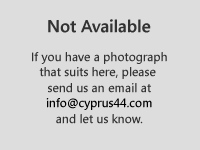
Panaya Kanakaria Church in Famagusta, North Cyprus.
 |
the north cyprus travel guide |
 |
|
Panaya Kanakaria Church
The Byzantine monastery of Panaya Kanakaria was established on this site by the 5th century AD, at which time a church was built. This church was replaced by another in the 11th century, but a Byzantine mosaic from the previous church, made in 525-550 AD, was retained in the central apse. The mosaic of the Virgin and Child included figures of an angel and Saint James and Saint Andrew. The high drummed cupola was added in the 1700s. The Panaya Kanakaria Church Mosaic, North CyprusNowadays the church is kept locked, after a notorious theft of the remains of the Byzantine mosaic. For years, local people believed that the small tiles used in the mosaic, the tesserae, could cure skin disease. However, at some point between 1974 and 1979, thieves broke into the monastery with the intent of stealing the entire mosaic. Four pieces of the mosaic were chipped away, and sold on the black market in Europe. The fragments resurfaced when an American art dealer bought them for $1million in the late 1980s from two dealers, Aydin Dikmen and Michel van Rijn, who claimed to have a North Cyprus export permit. The American dealer tried to sell the mosaic fragments to a museum in California, who realised something wasn’t right, and contacted the police. The Cypriot authorities were informed, and the south Cyprus government sued for the return of the mosaics, and won the case. The mosaics returned not to their original home in North Cyprus, but to a specially wing of a museum in south Cyprus. (Dikmen was later discovered to have roomfuls of treasure looted from North Cyprus, all of which is now held in South Nicosia.) Outside the church the monastery buildings themselves are decaying, although the ceiling above the entrance still has its 1779 fresco of the Virgin Mary. |
|
North Cyprus quick: holidays | flights | hotels | property | kyrenia | famagusta | photos | map | weather | history | news
All text is copyrighted by Cyprus44. Photographs are copyrighted by their respective photographers.
For more information read our copyright policy, privacy policy and disclaimer.
This web page is served on 18 September 2025 at 3:12:06 PM.
![]()
Cyprus44 in other languages: Nordzypern | Chypre Nord | Severní Kypr | Северный Кипр
partner sites: goNorthCyprus Travel | Pacific Rent-A-Car | Amy Holiday Villas | other partner sites








